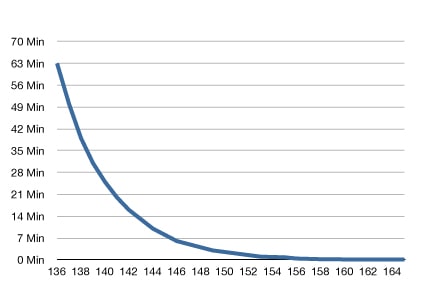This danger zone is why we refrigerate our foods until an hour or so before we are ready to cook them. It is also why we cook our foods to specific temperatures before we eat them.
The biggest misconception about bacteria and the danger zone is that any food in the temperature range is not safe and as soon as you move above 130°F the food instantly becomes safe. The truth is that the bacteria begin to die in direct relation to the temperature they are exposed to.
The best way to visualize this is to think about how we humans react to heat. We do fine in climates where the temperature is below 100°F. However, once it begins to climb around 110°F or 120°F you begin to hear about deaths in the news due to heat stroke. If the temperature were to raise to 200°F stepping outside for more than a few seconds would kill you.
Bacteria behave in the exact same way. They begin to die at around 130°F to 135°F and 165°F just about instantly kills them. You can see this in the chart below, based on the USDA data. At 136°F it takes about 63 minutes for your food to be safe and at 146°F it only takes 7 minutes to become safe.
 This concept is why the USDA recommends that chicken is cooked to 165°F, because at that temperature it takes only a few seconds for enough bacteria to die to achieve acceptable safety levels. In comparison, at 136°F it takes 63.3 minutes at that temperature to achieve the same safety level, something that is virtually impossible using traditional cooking methods. Using sous vide makes it possible to heat chicken and other meats to an internal temperature of as low as 130°F and hold it there long enough to kill the bacteria.
This concept is why the USDA recommends that chicken is cooked to 165°F, because at that temperature it takes only a few seconds for enough bacteria to die to achieve acceptable safety levels. In comparison, at 136°F it takes 63.3 minutes at that temperature to achieve the same safety level, something that is virtually impossible using traditional cooking methods. Using sous vide makes it possible to heat chicken and other meats to an internal temperature of as low as 130°F and hold it there long enough to kill the bacteria. Please remember that this is assuming that your thermometer is exact and the water temperature is completely steady. I recommend always cooking foods at a little higher than the minimum temperature and a little longer than the minimum cooking time in order to account for any variance in temperature your equipment causes.
For more information about how long chicken, poultry, and beef need to be held at certain temperatures please refer to the USDA Guide mentioned in our Resources chapter. For more explanations of how this works you can reference the excellent guides by Douglas Baldwin or Serious Eats mentioned in our Resources chapter.

